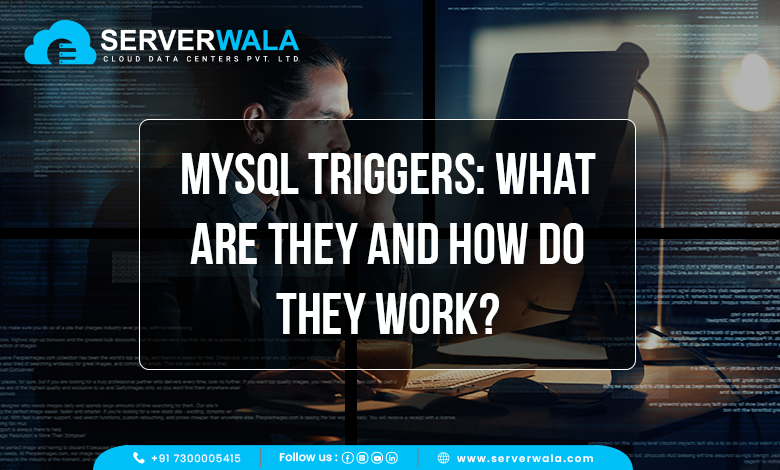MySQL Triggers: What are They and How Do They Work?

Introduction
Welcome to our exploration of MySQL triggers – a powerful feature that can enhance the functionality and automation of your MySQL database. If you’re curious about how MySQL triggers work and want to grasp their significance in database management, you’re in the right place. In this blog, we will unravel the concept of MySQL triggers, delve into their workings, and provide practical examples to illustrate their application.
What is a Trigger in MySQL?
In the realm of MySQL, a trigger is an array of instructions. These instructions are automatically implemented (“triggered”) in response to a particular situation happening on a particular table or view. These events/situations can incorporate INSERT, UPDATE, DELETE, or even the attempt to modify a column value before it is stored. Think of triggers as automated reactions to changes in your database, allowing you to enforce business rules, maintain data integrity, or automate complex operations.
MySQL triggers consist of three main components:
Event: This specifies the action that triggers the execution of the trigger, such as BEFORE or AFTER an INSERT, UPDATE, or DELETE operation.
Condition: An optional element that defines a condition that must be satisfied for the trigger to implement. If no condition is specified, the trigger will fire for all occurrences of the specified event.
Action: The array of SQL statements that are implemented as soon as the trigger is activated. These statements can be used to modify data, enforce constraints, or perform other operations based on the triggering event.
Using MySQL Triggers
MySQL triggers are invaluable tools for automating tasks and enforcing rules within your database. In this section, we’ll delve into the practical aspects of using triggers, covering everything from creating and deleting triggers to demonstrating various trigger examples.
Create Triggers
Creating a trigger involves specifying the event, condition, and action. For instance, let’s create a simple trigger that updates a ‘last_modified’ timestamp whenever a record is updated in a hypothetical ’employees’ table:
This trigger is designed to activate before an UPDATE operation on the ’employees’ table, updating the ‘last_modified’ column with the current timestamp.
Delete Triggers
If you are required to remove a trigger, you can use the DROP TRIGGER statement followed by the trigger name. For example:
This statement ensures that the ‘update_last_modified’ trigger is deleted if it exists.
Create Example Database
Let’s set up a simple example database to showcase different trigger scenarios. We’ll use a ‘tasks’ table for demonstration purposes:
Creating a sample ‘tasks’ table provides a practical foundation for illustrating the diverse applications of triggers.
Create a BEFORE INSERT Trigger
Suppose you want to automatically set the ‘task_status’ to ‘Pending’ before inserting a new task:
Now, whenever you insert a new task, the trigger will set its status to ‘Pending’ by default, streamlining the process of populating initial values.
Create an AFTER INSERT Trigger
Building on the previous example, let’s create a trigger that updates the ‘last_updated’ timestamp after a new task is inserted:
This trigger ensures that the ‘last_updated’ column is automatically populated with the current timestamp after a new task is added, enhancing data tracking capabilities.
Create a BEFORE UPDATE Trigger
Consider a scenario where you want to prevent tasks from being marked as ‘Completed’ if their status is ‘Cancelled.’ This could be acquired with a BEFORE UPDATE trigger:
This trigger checks if the new status is ‘Cancelled’ before an update and raises an error if an attempt is made to mark the task as ‘Completed,’ ensuring data consistency.
Create an AFTER UPDATE Trigger
Building on the previous example, let’s create an AFTER UPDATE trigger that logs any status changes:
This trigger inserts a record into a ‘status_log’ table, capturing the task_id, old_status, new_status, and the timestamp of the change after an update operation. This enhances audit trail capabilities.
Create a BEFORE DELETE Trigger
Suppose you want to prevent the deletion of tasks that are marked as ‘InProgress’:
This trigger checks if the task to be deleted has a status of ‘InProgress’ and raises an error if so, preventing accidental deletions that could compromise data integrity.
Create an AFTER-DELETE Trigger
For our last example, let’s create an AFTER DELETE trigger that updates a summary table:
This table will hold the count of total tasks for each status. And adjust the status values based on your application’s specific task statuses.
This trigger decreases the total_tasks count in a ‘task_summary’ table when a task is deleted, ensuring that summary information remains accurate.
Construct Multiple Triggers
One of the powerful features of MySQL is the ability to have multiple triggers for the same event on a table. This flexibility allows you to execute a series of actions in response to a single database event. But, it is vital to be aware of the execution order, as it can significantly influence the final outcome. Here is how you are able to construct & administer multiple triggers:
In this example, two triggers, first_trigger and second_trigger, are created to respond to the same AFTER INSERT event on the your table. It is significant to note that the order of trigger implementation is not assured unless explicitly specified.
Show Triggers
To view the existing triggers in your database, you can use the following command:
SHOW TRIGGERS;This command provides information about the triggers defined in your database, including their names, events, and timing. Regularly checking your triggers can help ensure proper maintenance and troubleshooting of your database setup.
Also Read: Syntax of Linux Set Command & How to Use it
Final Words
In concluding our journey through MySQL triggers, we’ve unveiled a robust tool that elevates the efficiency and reliability of your database management. MySQL triggers serve as indispensable allies, automating tasks and upholding data integrity with precision. As you navigate the realm of triggers, remember the potency they bring to your applications—streamlining processes, enforcing rules, and adapting dynamically to your unique business needs.
Integrating MySQL triggers into your database strategy offers not just automation, but a comprehensive solution for maintaining a structured and responsive data environment. Whether you’re orchestrating intricate actions or safeguarding against inconsistencies, triggers empower you to shape a resilient database architecture. As you embark on this MySQL adventure, embrace curiosity, experiment with trigger examples, and harness the full potential of this feature. Thank you for accompanying us on this exploration, and may your coding endeavors be filled with efficiency and innovation. Stay tuned for more deep dives into database management, SQL best practices, and emerging technological landscapes. Happy coding!





